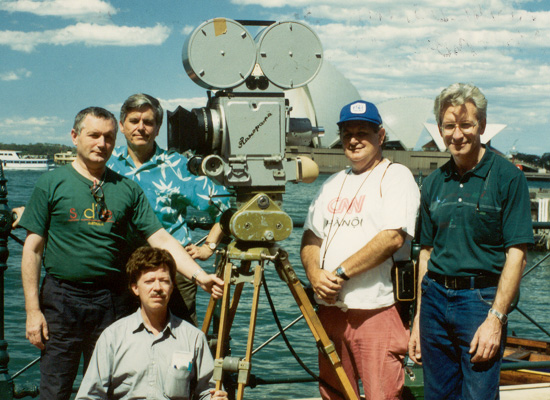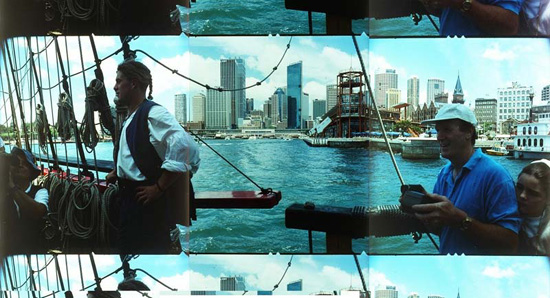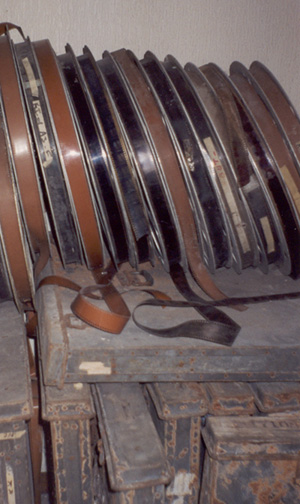Chastity, Truth and Kinopanorama
|
Read more
at in70mm.com The 70mm Newsletter |
| Written by: Jeremy Sefton-Parke (Alias John Steven Lasher). All Rights Reserved. Reproduced by written permission. | Date: May 6, 2003 |
 Kinopanorama
crew
in Sydney including. Director of Photography John R. McLean, Producer John
Steven Lasher, and Technical liaisons Sergey Rozhkov, Igor
Shevtsov and John Mitchell (in a blue shirt). Producer John "the
hobbit" Steven Lasher at the bottom. Copyright Kinopanorama Music & Vision. Kinopanorama
crew
in Sydney including. Director of Photography John R. McLean, Producer John
Steven Lasher, and Technical liaisons Sergey Rozhkov, Igor
Shevtsov and John Mitchell (in a blue shirt). Producer John "the
hobbit" Steven Lasher at the bottom. Copyright Kinopanorama Music & Vision.In 1992, following the launch of what at the time was the world's only three-projector Cinerama theatre at Pictureville, an entertainment complex at the National Museum of Photography, Film and Television in Bradford, West Yorkshire, UK, John Steven Lasher, the director of Fifth Continent Australia Pty Limited, a company then engaged in the production of audio compact disc recordings, hit upon an idea several of his colleagues considered 'pure folly'. "I'll shoot a new film with an original Cinerama camera for future screening at Pictureville", he announced. |
More
in 70mm reading: • Kinopanorama Films • Panorama Cinema in Moscow • Kinopanorama in Paris • Kinopanorama Update • Lost Orphaned Film • Soviet Circular Panorama • Sovscope 70 • "War and Peace" in 70mm • Foreign 70mm Films in Russia • Kinopanorama History • The latest from Kinopanorama • Kinopanorama Camera • Lashers' Kinopanorama • "Bounty" credits Internet link: Kinopanorama Paris Kinopanorama in Moscow: Ukraine Kinopanorama cinema: J S Lasher interview from “Home Theatre High Fidelity” Bernard Herman society J S Lasher interview: |
Easier said than done! |
|
 Kinopanorama
crew
in Sydney including John Mitchell in a blue shirt. Copyright Kinopanorama Music & Vision. Kinopanorama
crew
in Sydney including John Mitchell in a blue shirt. Copyright Kinopanorama Music & Vision.Lasher, a man for whom the word 'no' does not exist, remained undeterred, despite confirmed reports that the Cinerama camera equipment was not available (Cinemiracle cameras had been converted some three decades previously for special-effects use). After all, he reasoned, there was still the Soviet Kinopanorama system about which little was known. Lasher's inquires about Kinopanorama through the Russian Consulate in Sydney produced information which enabled him to contact Yuri Sokol (ACS), a Russian born director of photography living in Australia. Through Sokol's many contacts in the former Soviet Union one of the six Kinopanorama sound cameras (the PSO-1960 model) was located in salvageable condition. The good news, too, was that it could be restored and that it was available for purchase. |
|
 Kinopanorama
crew
working in Sydney harbour. Copyright Kinopanorama Music & Vision. Kinopanorama
crew
working in Sydney harbour. Copyright Kinopanorama Music & Vision.Lasher agreed to proceed with the restoration, which was undertaken over a period of several-months in early 1993 at The Cinema and Photo Research Institute (NIKFI) -- the impressive facility which for many decades has been devoted to designing, testing and improving every type of equipment and material used in motion production and presentation in the USSR -- under the close supervision of the Russian scientist and film technician, Sergei Rozhkov (who had previously receive an Oscar for the development of 70mm 3-D stereoscopic process marketed as StereoFilm), and the esteemed screen writer, Igor Shevtsov. Some six minutes were shot on readily available Sovcolor ORWO (echt Agfa) film stock around the City of Moscow in August (when weather conditions were most favourable), filming such eponymous landmarks as the Kremlin, Red Square, Russian White House, Sparrow Hills lookout (a favourite spot for wedding receptions, one of which was captured by the film crew) and the facade of the world famous Bolshoi Theatre. In September, Rozhkov and Shevtsov were granted authority by the Russian Ministry of Aviation to shoot footage of an Aeroflot-Russian International Airlines Airbus at Sheremetyevo II international airport. Such permission in pre-glasnost Russia would have been unthinkable. Several medium close-ups of the airplane taxiing and a long-shot of the takeoff were captured to the satisfaction of the film-makers. A standard work-print ("very flat and poorly graded", recalls Lasher) on SVEMA colour stock was struck from the camera negatives, and couriered in September to Sydney for screening at a private cinema with Lasher and Sokol in attendance. The results were impressive. Lasher invited Sergei Rozhkov and Igor Shevtsov to accompany the equipment to Australia, where they were employed to supervising the shooting of a short travelogue (later given the working-title, “Bounty”), with which Lasher planned to re-introduce the format to the public. |
|
 Old
Kinopanorama films in a house just south of Paris, France. 1996 picture
from Editors collection. Old
Kinopanorama films in a house just south of Paris, France. 1996 picture
from Editors collection.Four years later (in 1996) he decided to edit some of the Moscow footage into a 4-minute 'trailer' -- a non-technical introduction about Kinopanorama, which he reasoned could be screened at film festivals along with other wide screen formats. He wrote a tongue-in-cheek voiceover script, hired Australian cricket legend, Greg Matthews, and Sven Libaek (who had appeared in the only Cinemiracle film, “Windjammer”) to narrate the Moscow footage, accompanied on the soundtrack by music of the Russian composer Anatol Liadov. An SFX library provided actual sound effects of an Airbus for the footage at Sheremetyevo. Lasher gave the film the humorous title, “Chastity Truth and Kinopanorama”, which he has often been obliged to inform others is a pun on Tarantino's [Steven Soderberg, Ed] film, “Sex Lies and Videotape”. The music and voiceovers were recorded at Sony Music Studios (Sydney). Editing and mixing were completed at Studios 301, where Lasher had produced CD albums in the past years with multi track digital recorders manufactured by Tascam and Sony were used. With post-production sound work completed "...without too much drama", according to Lasher, the next step entailed the transfer from the multi-track digital masters to the 35mm magnetic film seven- channel soundtrack. It was here that Lasher would encounter a major problem in preparing the film for a public screening at the March 1997 Bradford Wide Screen Film Festival. |
|
 Old
Kinopanorama films in a house just south of Paris, France. 1996 picture
from Editors collection. Old
Kinopanorama films in a house just south of Paris, France. 1996 picture
from Editors collection.Although Lasher had contracted for the sound transfers to be carried out by Jack Dimmers, a former Cinerama employee who had completely restored the original Cinerama 35mm film dubbers at Teccon Industries in Los Angeles, he was in poor health and unable to complete the job. As no other professional Cinerama 35mm dubbers existed Lasher was obliged to screen a work-print of the film with the digital soundtrack played back 'horrendously out-of-synch' for the Bradford audience. Thomas Hauerslev, the editor of The 70mm Newsletter, still refers to the film, which also suffered from lack of rehearsal time allocated to the harried Pictureville projectionists (who also treated the screenings with indifference) as being 'almost screened' on his website. With no further screenings anticipated in the foreseeable future, Lasher promptly forgot about the film as other more important projects loomed. In 1998, however, shortly after a custom built seven-channel 35mm film recorder and playback unit ordered from The Aranda Group at a cost in excess of $20,000.00 was delivered to Fifth Continent, Lasher changed his mind about what to do with the edited work-print. After all, it was now possible to complete post-production work on the soundtracks with the new 35mm film recorder. Lasher returned to Studios 301, where over a period of many months (including delays caused by a dispute with the manufacturer over a defective amplifier, and, later, with the studio itself over distortion caused by over modulation in the sound transfers) the dubbing was completed to his satisfaction. Finally, in 2002, the camera negatives and the edited work-print (which had begun to fade) were shipped out to Moscow. Once again his Russian colleagues pulled out all the stops to deliver a release print, which any film maker could exhibit with pride at film festivals. All said and done, however, Lasher is awaiting his first rental inquiry. "I believe", he says rather, philosophically, "that the 'Cinerama mafia' aren't terribly keen on a rival panoramic format -- one that is alive and well -- upstaging one of their films at public screenings. As both systems were designed to coexist all that is required of the projectionists is to allocate a nominal amount of time to realign the 'Abel' and 'Charlie' projectors to prevent double images where each of the panels of Kinopanorama films overlap". |
|
|
Go: back
- top - back issues
- news index Updated 22-01-25 |
|
